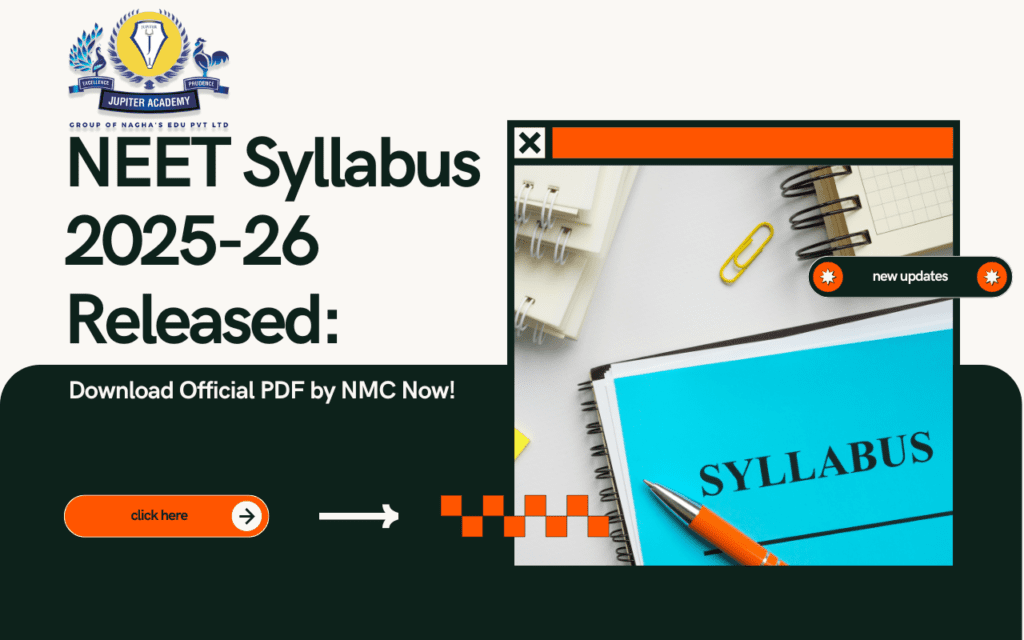NEET Syllabus 2025-26 Released: Download Official PDF by NMC Now!

The NEET Syllabus 2025, finalized by NMC and updated by UGMEB, includes Physics, Chemistry, and Biology topics. Candidates can download the NEET 2025 Syllabus PDF and check the official notification here.
NEET Syllabus 2025-26 Out: Download the Official PDF by NMC
The National Medical Commission (NMC) has released the official NEET 2025-26 syllabus. With clarity on the exam topics, it’s time to align your preparation strategy with the updated syllabus for Physics, Chemistry, and Biology.
Key Features of the NEET 2025-26 Syllabus
No Major Changes from Previous Year:
The syllabus remains similar to that of NEET 2024-25, ensuring consistency.Aligned with NCERT:
The syllabus is structured as per Class 11 and Class 12 NCERT textbooks, making them the primary resources for preparation.Subject-Wise Weightage:
- Physics: 45 questions
- Chemistry: 45 questions
- Biology: 90 questions
Official PDF Available:
Download the NMC-approved NEET syllabus 2025-26 PDF for easy access.
NEET Syllabus 2025-26 Overview
| NEET Syllabus 2025 Overview | |
| Parameter | Details |
| Official Release | 2024 |
| Authority | National Testing Agency (NTA) |
| Syllabus Availability | Available on NTA’s official website |
| Document Format | |
| Key Sections | Physics, Chemistry, Biology |
| Changes from the Previous Year | Yes (Specified in the revised sections) |
| Accessibility | NEET 2025 syllabus PDF by NTA is Available |
| Applicability | Mandatory for NEET 2025 aspirants |
NEET Syllabus 2025 – Subjects Wise Breakdown
| NEET Syllabus 2025 – Subjects Wise Breakdown | ||
|---|---|---|
| Biology | Physics | Chemistry |
| Diversity of Living Organisms Change | Physics And Measurement | Some Basic Concepts of Chemistry |
| Structural Organization in Plants & Animals Change | Kinematics | Structure of Atom |
| Cell Structure and Function No Change | Laws Of Motion | Classification of Elements and Periodicity in Properties |
| Plant Physiology | Work, Energy, and Power | Chemical Bonding and Molecular Structure |
| Human Physiology | Rotational Motion | States of Matter: Gases and Liquids |
| Reproduction | Gravitation | Thermodynamics |
| Genetics & Evolution | Properties of Solids and Liquids | Equilibrium |
| Biology and Human Welfare | Thermodynamics | Redox Reactions |
| Biotechnology and its Applications | Kinetic Theory of Gases | Classification of Elements and Periodicity in Properties |
| Ecology and Environment | Oscillation and Waves | P-Block Elements |
| – | Electrostatics | d- and f-Block Elements |
| – | Current Electricity | Coordination Compounds |
| – | Magnetic Effects of Current and Magnetism | Purification and Characterisation of Organic Compounds |
| – | Electromagnetic Induction and Alternating Currents | Some Basic Principles of Organic Chemistry |
| – | Electromagnetic Waves | Hydrocarbons |
| – | Optics | Organic Compounds Containing Halogens |
| – | Dual Nature of Matter and Radiation | Organic Compounds Containing Oxygen |
| – | Atoms and Nuclei | Organic Compounds Containing Nitrogen |
| – | Electronic Devices | Biomolecules |
| – | Experimental Skills | Principles Related to Practical Chemistry |
Download Official NEET 2025 Syllabus PDF
NEET Syllabus 2025 for Biology
NEET Syllabus 2025 Classwise for Biology | |
|---|---|
| Unit Name | Unit Topics |
| Class 11 | |
| Unit 1 – Diversity of Living Organisms Change |
|
| Unit 2 – Structural Organization in Plants & Animals Change |
|
| Unit 3 – Cell Structure and Function No Change |
|
| Unit 4 – Plant Physiology |
|
| Unit 5 – Human Physiology |
(lmportant: Diseases and disorders mentioned above to be dealt with in brief.) |
| Class 12 | |
| Unit 6 – Reproduction |
|
| Unit 7 – Genetics & Evolution |
|
| Unit 8 – Biology and Human Welfare |
|
| Unit 9 – Biotechnology and its Applications |
|
| Unit 10 – Ecology and Environment |
|
NEET Syllabus 2025 for Physics
| NEET Syllabus 2025 Classwise for Physics | |
|---|---|
| Unit Name | Unit Topics |
| Class 11 | |
| UNIT I: Physics And Measurement |
|
| UNIT 2: Kinematics |
|
| UNIT 3: Laws Of Motion |
|
| UNIT 4: Work, Energy, and Power |
|
| UNITS: Rotational Motion |
|
| UNIT 6: Gravitation |
|
| UNIT 7: Properties of Solids and Liquids |
|
| UNIT 8: Thermodynamics |
|
| Unit 9: Kinetic Theory of Gases |
|
| UNIT 10: Oscillation and Waves |
|
| Class 12 | |
| Unit 11: Electrostatics |
|
| Unit 12: Current Electricity |
|
| Unit 13: Magnetic Effects of Current and Magnetism |
|
| Unit 14: Electromagnetic Induction and Alternating Currents |
|
| Unit 15: Electromagnetic Waves |
|
| Unit 16: Optics |
|
| Unit 17: Dual Nature of Matter and Radiation |
|
| Unit 18: Atoms and Nuclei |
|
| Unit 19: Electronic Devices |
|
| Unit 20: Experimental Skills |
|
NEET Syllabus 2025 for Chemistry
NEET 2025 Syllabus for Physical Chemistry
Class 11 Physical Chemistry | |
|---|---|
| Unit | Topics Covered |
| UNIT 1: Some Basic Concepts of Chemistry | Matter and its nature, Dalton’s atomic theory, laws of chemical combination, concept of elements, atoms, and molecules, atomic and molecular masses, mole concept and molar mass, percentage composition, empirical and molecular formulae, chemical reactions, stoichiometry |
| UNIT 2: Structure of Atom | Discovery of electron, proton, and neutron, atomic number, isotopes and isobars, Thompson’s model and its limitations, Rutherford’s model and its limitations, Bohr’s model and its limitations, concept of shells and subshells, dual nature of matter and light, de Broglie’s relationship, Heisenberg uncertainty principle, the concept of orbitals, quantum numbers, shapes of s, p and d orbitals, rules for filling electrons in orbitals – Aufbau principle, Pauli exclusion principle, Hund’s rule, electronic configuration of atoms, stability of half-filled and filled orbitals |
| UNIT 3: Classification of Elements and Periodicity in Properties | Significance of classification, development of the periodic table, modern periodic law and the present form of the periodic table, periodic trends in properties of elements – atomic radii, ionic radii, ionization enthalpy, electron gain enthalpy, electronegativity, valence |
| Class 12 Physical Chemistry | |
| UNIT 4: Chemical Bonding and Molecular Structure | Valence electrons, ionic bond, covalent bond, bond parameters, Lewis structure, the polar character of covalent bond, the covalent character of ionic bond, valence bond theory, resonance, the geometry of covalent molecules, VSEPR theory, the concept of hybridization involving s, p, and d orbitals, molecular orbital theory of homonuclear diatomic molecules (qualitative idea only), hydrogen bond |
| UNIT 5: States of Matter: Gases and Liquids | Three states of matter, intermolecular interactions, types of bonding, melting and boiling points, role of gas laws in elucidating the concept of the molecule, Boyle’s law, Charle’s law, Gay Lussac’s law, Avogadro’s law, ideal behavior, empirical derivation of gas equation, Avogadro number, ideal gas equation, kinetic energy and molecular speeds (elementary idea), deviation from ideal behavior, liquefaction of gases, critical temperature, Liquid State – Vapour pressure, viscosity, and surface tension (qualitative idea only, no mathematical derivations) |
| UNIT 6: Thermodynamics | Concepts of system, types of systems, surroundings, work, heat, energy, extensive and intensive properties, state functions, the first law of thermodynamics – internal energy and enthalpy, heat capacity and specific heat, measurement of ΔU and ΔH, Hess’s law of constant heat summation, enthalpy of bond dissociation, combustion, formation, atomization, sublimation, phase transition, ionization, solution, and dilution, the introduction of entropy as a state function, the second law of thermodynamics, Gibbs energy change for spontaneous and non-spontaneous process, criteria for equilibrium, the third law of thermodynamics – a brief introduction |
| UNIT 7: Equilibrium | Equilibrium in physical and chemical processes, dynamic nature of equilibrium, law of mass action, equilibrium constant, factors affecting equilibrium – Le Chatelier’s principle, ionic equilibrium – ionization of acids and bases, strong and weak electrolytes, degree of ionization, ionization of polybasic acids, acid strength, concept of pH., Hydrolysis of salts (elementary idea), buffer solutions, Henderson equation, solubility product, common ion effect (with illustrative examples) |
| UNIT 8: Redox Reactions | Concept of oxidation and reduction, redox reactions, oxidation number, balancing redox reactions in terms of loss and gain of electron and change in oxidation numbers, applications of redox reactions |
NEET 2025 Syllabus for Inorganic Chemistry
| Class 11 Inorganic Chemistry | |
|---|---|
| Unit | Topics Covered |
| UNIT 9: Classification of Elements and Periodicity in Properties | Modern periodic law and the current form of the periodic table; s, p, d, and f-block elements; Periodic trends in properties such as atomic and ionic radii, ionization enthalpy, electron gain enthalpy, valence, oxidation states, and chemical reactivity. |
| Class 12 Inorganic Chemistry | |
| UNIT 10: P-Block Elements | General Introduction; Electronic configuration; General trends in physical and chemical properties; Unique behavior of the first element of each group; Group 13 to Group 18 elements. |
| UNIT 11: d- and f-Block Elements | General introduction, electronic configurations, occurrence, and characteristics of transition elements; General trends in properties such as physical properties, ionization enthalpy, oxidation states, atomic radii, color, catalytic behavior, magnetic properties, complex formation; Preparation, properties, and uses of compounds like K₂Cr₂O₇ and KMnO₄; Lanthanoids and actinoids, including electronic configurations, oxidation states, and lanthanoid contraction. |
| UNIT 12: Coordination Compounds | Introduction to coordination compounds; Werner’s theory; Ligands, coordination number, denticity, chelation; IUPAC nomenclature of mononuclear coordination compounds; Isomerism; Bonding: Valence bond approach and basic ideas of Crystal field theory; Color and magnetic properties; Importance of coordination compounds in qualitative analysis, extraction of metals, and in biological systems. |
NEET 2025 Syllabus for Organic Chemistry
| NEET 2025 Syllabus for Class 11 Organic Chemistry | |
|---|---|
| Unit | Topics Covered |
| UNIT 13: Purification and Characterisation of Organic Compounds | Purification methods (crystallization, sublimation, chromatography, distillation, differential extraction); qualitative and quantitative analysis including detection of elements (N, S, P, halogens) and calculations of empirical and molecular formulas. |
| UNIT 14: Some Basic Principles of Organic Chemistry | Tetra-valency of carbon, hybridization, classification based on functional groups, isomerism, nomenclature, types of organic reactions (substitution, addition, elimination, rearrangement), electronic effects (inductive, electromeric, resonance, hyperconjugation). |
| UNIT 15: Hydrocarbons | Classification and isomerism; Alkanes, Alkenes, and Alkynes – structure, properties, and reactions; Aromatic hydrocarbons – structure, aromaticity, electrophilic substitution reactions. |
| Class 11 Organic Chemistry | |
| UNIT 16: Organic Compounds Containing Halogens | Preparation, properties, and reactions of haloalkanes and haloarenes; environmental effects of compounds like chloroform and DDT. |
| UNIT 17: Organic Compounds Containing Oxygen | Properties and reactions of alcohols, phenols, ethers, aldehydes, ketones, carboxylic acids; important organic reactions such as nucleophilic addition and condensation. |
| UNIT 18: Organic Compounds Containing Nitrogen | Amines and diazonium salts – preparation, properties, reactions, and uses; importance in synthetic organic chemistry. |
| UNIT 19: Biomolecules | Classification and functions of carbohydrates, proteins, vitamins, nucleic acids; structure and function of biomolecules in biological processes. |
| UNIT 20: Principles Related to Practical Chemistry | Detection of elements and functional groups in organic compounds; principles involved in the preparation of specific inorganic and organic compounds; qualitative and quantitative analysis including titrimetric and gravimetric analysis. |
Chapter-wise Weightage in NEET Previous Year Paper
Biology Chapter-wise Weightage in NEET 2024 Paper
| Biology Chapter-wise Weightage in NEET 2024 Paper | ||
|---|---|---|
| Class | Chapter Name | No. of Questions |
| Biology Chapter-wise Weightage in NEET 2024 Paper | ||
| 12th | Sexual Reproduction in Flowering Plants | 2 |
| 12th | Biodiversity and Conservation | 5 |
| 12th | Morphology of Flowering Plants | 5 |
| 11th | Anatomy of Flowering Plants | 3 |
| 11th | Photosynthesis in Higher Plants | 3 |
| 11th | Plant Growth and Development | 3 |
| 11th | Biological Classification | 2 |
| 12th | Organisms and Populations | 2 |
| 11th | Cell Cycle and Cell Division | 4 |
| 12th | Principles of Inheritance and Variation | 6 |
| 12th | Microbes in Human Welfare | 1 |
| 12th | Molecular Basis of Inheritance | 6 |
| 11th | Cell: The Unit of Life | 4 |
| 11th | Respiration in Plants | 2 |
| 12th | Ecosystem | 1 |
| 11th | Plant Kingdom | 1 |
| Grand Total | 50 | |
| Chapter-wise NEET 2024 Paper Analysis for Zoology | ||
| 11th | Biomolecules | 6 |
| 12th | Biotechnology – Principles and Processes | 5 |
| 12th | Biotechnology and its Applications | 4 |
| 12th | Human Health and Disease | 4 |
| 12th | Reproductive Health | 2 |
| 12th | Human Reproduction | 5 |
| 11th | Structural Organisation in Animals (Animal Tissues) | 3 |
| 11th | Neural Control and Coordination | 2 |
| 11th | Chemical Coordination and Integration | 2 |
| 11th | Locomotion and Movement | 3 |
| 12th | Evolution | 4 |
| 11th | Breathing and Exchange of Gases | 2 |
| 11th | Body Fluids and Circulation | 2 |
| 11th | Animal Kingdom | 4 |
| 11th | Excretory Products and their Elimination | 2 |
| Grand Total | 50 | |
Physics Chapter-wise Weightage in NEET 2024 Paper
| Physics Chapter-wise Weightage in NEET 2024 Paper | ||
|---|---|---|
| Class | Chapter Name | No. of Questions |
| 12th | Moving Charges and Magnetism | 1 |
| 12th | Magnetism and Matter | 4 |
| 11th | Thermodynamics | 1 |
| 12th | Wave Optics | 2 |
| 12th | Alternating Current | 2 |
| 12th | Semiconductor Electronics: Materials, Devices and Simple Circuits | 4 |
| 11th | Units and Measurements | 3 |
| 11th | Mechanical Properties of Solids | 2 |
| 11th | Laws of Motion | 1 |
| 12th | Dual Nature of Radiation and Matter | 2 |
| 12th | Electrostatic Potential and Capacitance | 4 |
| 12th | Electromagnetic Induction | 1 |
| 12th | Ray Optics and Optical Instruments | 2 |
| 11th | Rotational Motion | 2 |
| 12th | Current Electricity | 3 |
| 12th | Atoms | 2 |
| 12th | Nuclei | 1 |
| 11th | Work, Energy and Power | 1 |
| 11th | Gravitation | 2 |
| 11th | Circular Motion | 2 |
| 11th | Mechanical Properties of Fluids | 1 |
| 11th | Center of Mass and System of Particles | 1 |
| 11th | Oscillations | 2 |
| 11th | Kinetic Theory | 1 |
| 12th | Electromagnetic Waves | 2 |
| 11th | Motion in a Straight Line | 1 |
| Grand Total | 50 | |
Chemistry Chapter-wise Weightage in NEET 2024 Paper
| Physics Chapter-wise Weightage in NEET 2024 Paper | ||
|---|---|---|
| Class | Chapter Name | No. of Questions |
| 12th | Electrochemistry | 2 |
| 11th | Redox Reactions | 1 |
| 11th | Chemical Bonding and Molecular Structure | 3 |
| 12th | Aldehydes, Ketones and Carboxylic Acids | 3 |
| 11th | Some Basic Concepts of Chemistry | 3 |
| 12th | The d and f-Block Elements | 4 |
| 11th | Thermodynamics | 3 |
| 12th | Chemical Kinetics | 3 |
| 11th | Organic Chemistry: Some Basic Principles and Techniques | 4 |
| 11th | Classification of Elements and Periodicity in Properties | 2 |
| 12th | Alcohols, Phenols and Ethers | 2 |
| 12th | Coordination Compounds | 3 |
| 12th | The p-Block Elements (XII) | 2 |
| 11th | Structure of Atom | 2 |
| 12th | Biomolecules | 1 |
| 11th | Equilibrium | 3 |
| 11th | Hydrocarbons | 2 |
| 12th | Haloalkanes and Haloarenes | 2 |
| 12th | Amines | 2 |
| 12th | Solutions | 2 |
| 12th | Principles of Qualitative Analysis | 1 |
| Grand Total | 50 | |
NEET 2025 Official Syllabus PDF Download NEET 2025 Official Syllabus PDF Download NEET 2025 Official Syllabus PDF Download NEET Syllabus 2025-26 Released NEET Syllabus 2025-26 Released NEET Syllabus 2025-26 Released NEET Syllabus 2025-26 Released NEET Syllabus 2025-26 Released NEET Syllabus 2025 for Physics NEET Syllabus 2025 for Physics NEET Syllabus 2025 for Physics NEET Syllabus 2025 for Physics NEET Syllabus 2025 for Physics NEET Syllabus 2025 for Chemistry NEET Syllabus 2025 for ChemistryNEET Syllabus 2025 for Chemistry NEET Syllabus 2025 for Chemistry NEET Syllabus 2025 for Chemistry NEET Syllabus 2025-26 Released NEET Syllabus 2025-26 Released NEET Syllabus 2025-26 Released NEET Syllabus 2025-26 Released NEET Syllabus 2025-26 Released
NEET 2025 Official Syllabus PDF Download NEET 2025 Official Syllabus PDF Download NEET 2025 Official Syllabus PDF Download





